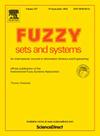MIAL (= SL)是最弱的子结构核心模糊逻辑吗?
IF 2.7
1区 数学
Q2 COMPUTER SCIENCE, THEORY & METHODS
引用次数: 0
摘要
在这里我们验证了以下两点:第一,只要系统接受序性,则可以将系统MIAL (= SL)视为最弱的子结构核心模糊关联逻辑。其次,可以通过删除身份来削弱mime。首先,我们首先验证了一些提供结构公理“同一性”弱形式的尝试失败了,然后提供了这些尝试失败的原因。接下来,我们验证了MIAL和它的一些扩展满足论文“R和相关原则重访”中引入的新的强弱相关原则。其次,我们引入1 - MAL作为一个比MAL弱的系统,并验证1 - MAL是一个子结构核心模糊关联逻辑。这意味着如果不考虑序性,mil不是最弱的子结构核心模糊逻辑。本文章由计算机程序翻译,如有差异,请以英文原文为准。
Is MIAL (= SLℓ) the weakest substructural core fuzzy logic?
Here we verify the following two: The first is that the system MIAL (= ) can be regarded as the weakest substructural core fuzzy and relevance logic as far as one accepts order property. The second is that MIAL can be weakened by deleting identity. For the first, we first verify that some attempts to provide weak forms of the structural axiom ‘identity’ fail and then provide a diagnose why such attempts fail. We next verify that MIAL and some of its extensions satisfy new strong and weak relevance principles introduced in the paper “R and relevance principle revisited.” For the second, we introduce MAL as a system weaker than MIAL and verify that MAL is a substructural core fuzzy and relevance logic. This implies that MIAL is not the weakest substructural core fuzzy logic if we do not suppose order property.
求助全文
通过发布文献求助,成功后即可免费获取论文全文。
去求助
来源期刊

Fuzzy Sets and Systems
数学-计算机:理论方法
CiteScore
6.50
自引率
17.90%
发文量
321
审稿时长
6.1 months
期刊介绍:
Since its launching in 1978, the journal Fuzzy Sets and Systems has been devoted to the international advancement of the theory and application of fuzzy sets and systems. The theory of fuzzy sets now encompasses a well organized corpus of basic notions including (and not restricted to) aggregation operations, a generalized theory of relations, specific measures of information content, a calculus of fuzzy numbers. Fuzzy sets are also the cornerstone of a non-additive uncertainty theory, namely possibility theory, and of a versatile tool for both linguistic and numerical modeling: fuzzy rule-based systems. Numerous works now combine fuzzy concepts with other scientific disciplines as well as modern technologies.
In mathematics fuzzy sets have triggered new research topics in connection with category theory, topology, algebra, analysis. Fuzzy sets are also part of a recent trend in the study of generalized measures and integrals, and are combined with statistical methods. Furthermore, fuzzy sets have strong logical underpinnings in the tradition of many-valued logics.
 求助内容:
求助内容: 应助结果提醒方式:
应助结果提醒方式:


